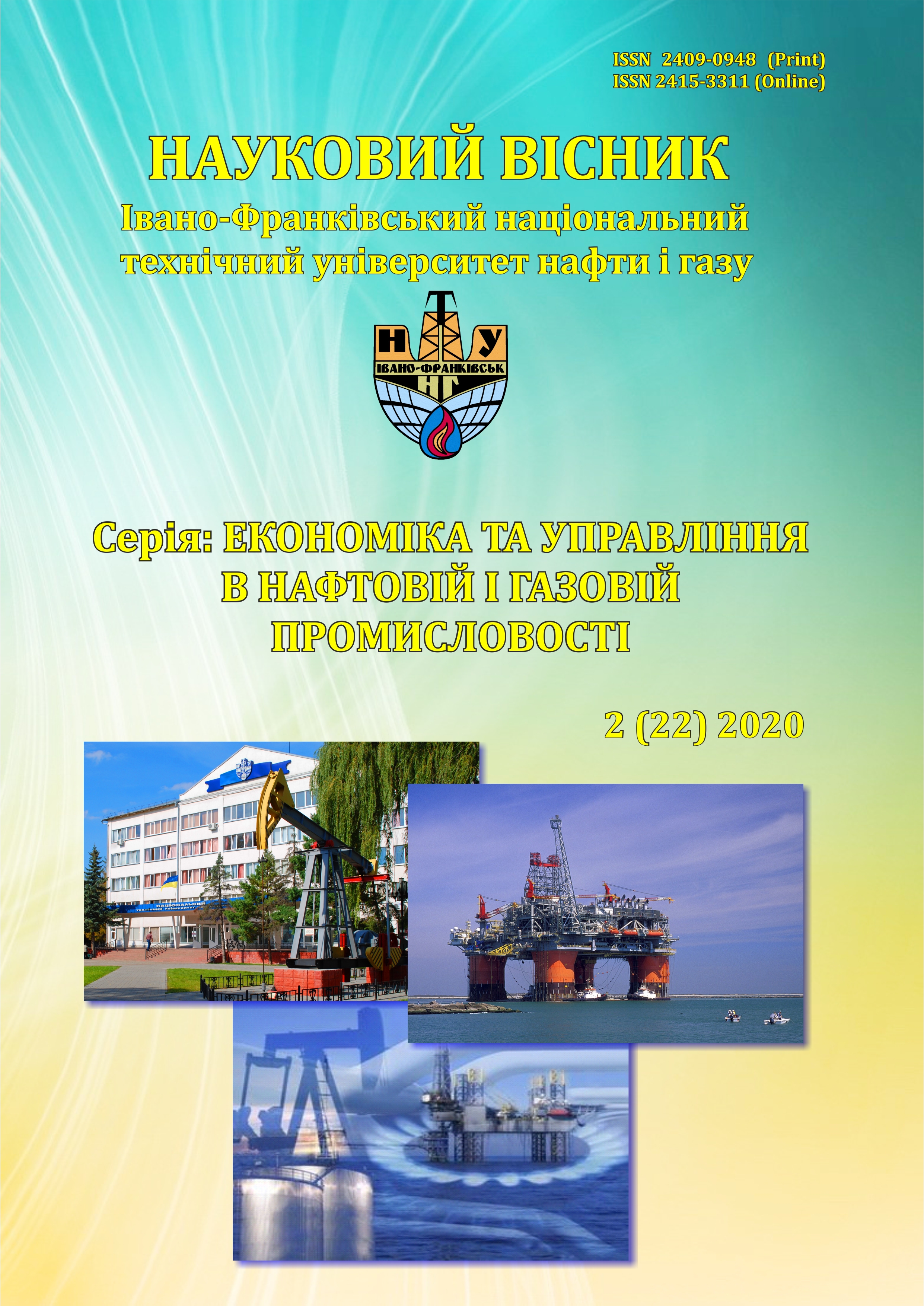METHODS OF REGULATION AND OPTIMIZATION OF PRODUCTION COSTS OF AGRICULTURAL SECTOR IN THE SYSTEM OF MANAGEMENT ACCOUNTING OF SMALL AND MEDIUM BUSINESS
DOI:
https://doi.org/10.31471/2409-0948-2020-2(22)-51-59Keywords:
costs, management accounting, cost accounting, production, livestock, calculation.Abstract
The article considers such a sphere of agriculture as animal husbandry, which remains one of the main branches in agriculture of small and medium business, in relation to the production of competitive products. Despite the large number of scientific studies, the issues of regulation and optimization of livestock production costs in the management accounting system remain unclear. Therefore, there is a need for further in-depth study of theoretical and methodological developments aimed at determining methods of regulation and optimization of livestock production costs in the management accounting system, which determines the relevance of the chosen topic. The article examines the issues of regulation and optimization of livestock production costs in the management accounting system, expanding the concept of «costs», consider methods of accounting for livestock production costs and emphasize the main points of cost accounting in production.
The production of competitive products and ensuring a stable position of enterprises in the agricultural market requires a change in the cost of livestock production by creating a perfect management accounting system, which allows to provide internal users with information for effective management.
It is stated that in theory and practice there are a number of features for the classification of costs, which take into account various aspects of the agricultural enterprise and form a variety of information for effective management decisions. Thus, experience and research show that the organization of management accounting within a particular agricultural enterprise, focused on meeting the specific information needs of the management system, will ensure its success in dynamic economic conditions and help solve a wide range of problems to optimize livestock production costs.
Thus, further research is formed on the formation of a system of accounting for the cost of production of livestock products, capable of generating information flows for management decisions, which requires a sound approach to determining the objects of accounting and costing, establishing their relationship and interdependence.
References
Butynets F. (2012). Vytraty vyrobnytstva ta yikh klasyfikatsiya dlya potreb upravlinnya.. Problems of theory and methodology of accounting, control and analysis. № 1. 11–18 [in Ukrainian].
Belova I. (2015). Sutʹ upravlinsʹkoho obliku ta yoho mistse v systemi upravlinnya pidpryyemstvom. Innovative economy. № 2 (57). 240–245. [in Ukrainian].
Golov S. (2007). Chy pereshkodzhaye P(s)BO 16 «Vytraty» ekonomichniy roboti na pidpryyemstvi? Accounting and auditing. № 5. 3–10. [in Ukrainian].
Hutsaliuk O. (2020). Obgruntuvannya orhanizatsiyno-ekonomichnoho mekhanizmu rehulyuvannya vytrat vyrobnytstva produktsiyi pidpryyemstv ahropromyslovoho kompleksu Ukrayiny. Substantiation of the organizational and economic mechanism of regulation of production costs of the enterprises of the agro-industrial complex of Ukraine. Peculiarities of socio-economic progress of the national economy in terms of information and technological challenges : a collective monograph / for science. ed. L. Kvasniy, I. Tatomir. Truskavets : Posvit. 102–111. [in Ukrainian].
Davydovych I. (2008). Upravlinnia vytratamy. Kyiv : Tsentr uchbovoi literatury. [in Ukrainian].
Len V. (2003). Upravlinsʹkyy oblik. Kiev : Knowledge-Press. [in Ukrainian].
Lukava I. (2003). Osoblyvosti diyuchoyi systemy upravlinsʹkoho obliku v roslynnytstvi. Reform of accounting, reporting and auditing in the system of agro-industrial complex of Ukraine: Status and prospects. Ch. I. Problems of adaptation of accounting of agro-industrial complex of Ukraine to international rules and requirements / ed. P. Sabluka, M. Demyanenko, V. Beetle. Kyiv : Institute of Agrarian Economics. 49–58. [in Ukrainian].
Paliy V. (2009). Upravlencheskyy uchet yzderzhek y dokhodov. Moscow : Infra-M. [in Russian].
Tarasova, T. O., Cherchata, A. O., Staverska, T. O. (2019). Oblikovo-analitychne zabezpechennia ryzyk-menedzhmentu v umovakh staloho rozvytku pidpryiemstva. Naukovyi visnyk Ivano-Frankivskoho natsionalnoho tekhnichnoho universytetu nafty i hazu (seriia «Ekonomika ta upravlinnia v naftovii i hazovii promyslovosti»), 2(20), 142-153. https://doi.org/10.31471/2409-0948-2019-2 (20)-142-153. [in Ukrainian]
Tkachenko N. (1997). Bukhhaltersʹkyy oblik na pidpryyemstvakh z riznymy formamy vlasnosti. Kyiv : A.S.K. [in Ukrainian].
Farion V. (2013). Sutnistʹ vytrat yak ekonomichnoyi katehoriyi. Bulletin of the Chernivtsi Trade and Economic Institute. Vip. 1 (49). Economic sciences. 44–47. [in Ukrainian].
Pro bukhhaltersʹkyy oblik ta finansovu zvitnistʹ v Ukrayini: zakon Ukrayiny vid 16 lypnya 1999 r., № 996-XIV (zi zminamy i dopovnennyamy). 1999, № 996-XIV. URL: www. ligazakon. ua. [in Ukrainian].
Polozhennya (standart) bukhhaltersʹkoho obliku 16 «Vytraty». URL: http://buhgalter911.com. [in Ukrainian].
Instruktsiya Pro zastosuvannya «Planu rakhunkiv bukhhaltersʹkoho obliku aktyviv, kapitalu, zobov'yazanʹ i hospodarsʹkykh operatsiy pidpryyemstv i orhanizatsiy» URL: https://zakon.rada.gov.ua/laws/show/z0893-99#Text [in Ukrainian].
Hutsaliuk O., Yaroshevska O., Shmatko N., Kulko-Labyntseva I., Navolokina A. (2020). Stakeholder approach to selecting enterprise-bank interaction strategies. Problems and Perspectives in Management. [in English].
Downloads
Published
How to Cite
Issue
Section
License
Copyright and Licensing Terms
Copyright Statement
The authors who publish in the journal accept the following conditions:
- The authors retain the copyright and grant the journal the right of first publication, licensed with Creative CommonsCC BY-NC-SA , which permits other people to remix, transform, and build upon the material and use the material for non-commercial purposes, give appropriate credit and distribute the contributions under the same license as the original.
- The authors can conclude additional agreements on the non-exclusive distribution of the journal’s published version of the work (for example, publication of the work in electronic repositories) with an acknowledgment of its initial publication in this journal.
- The authors can upload the published articles on the Internet (for example, in electronic repositories or on web-sites), as it will stimulate fruitful scholarly discussions and increase the citation rates of the published articles.


1.png)


1.png)





